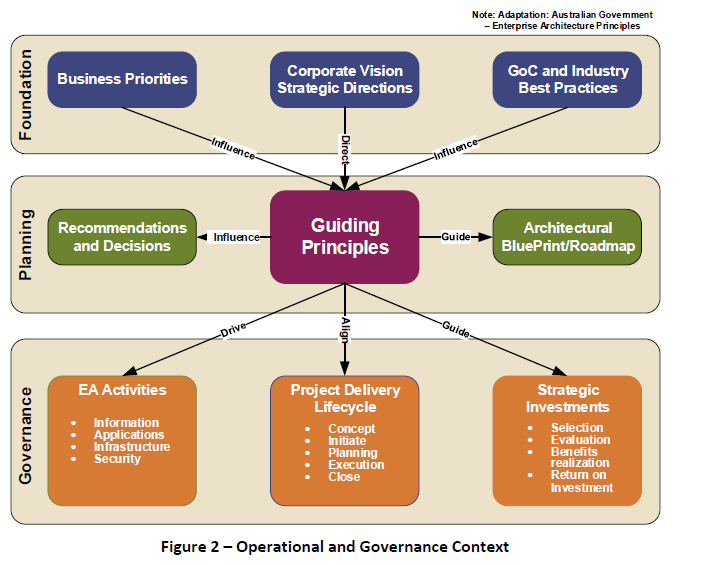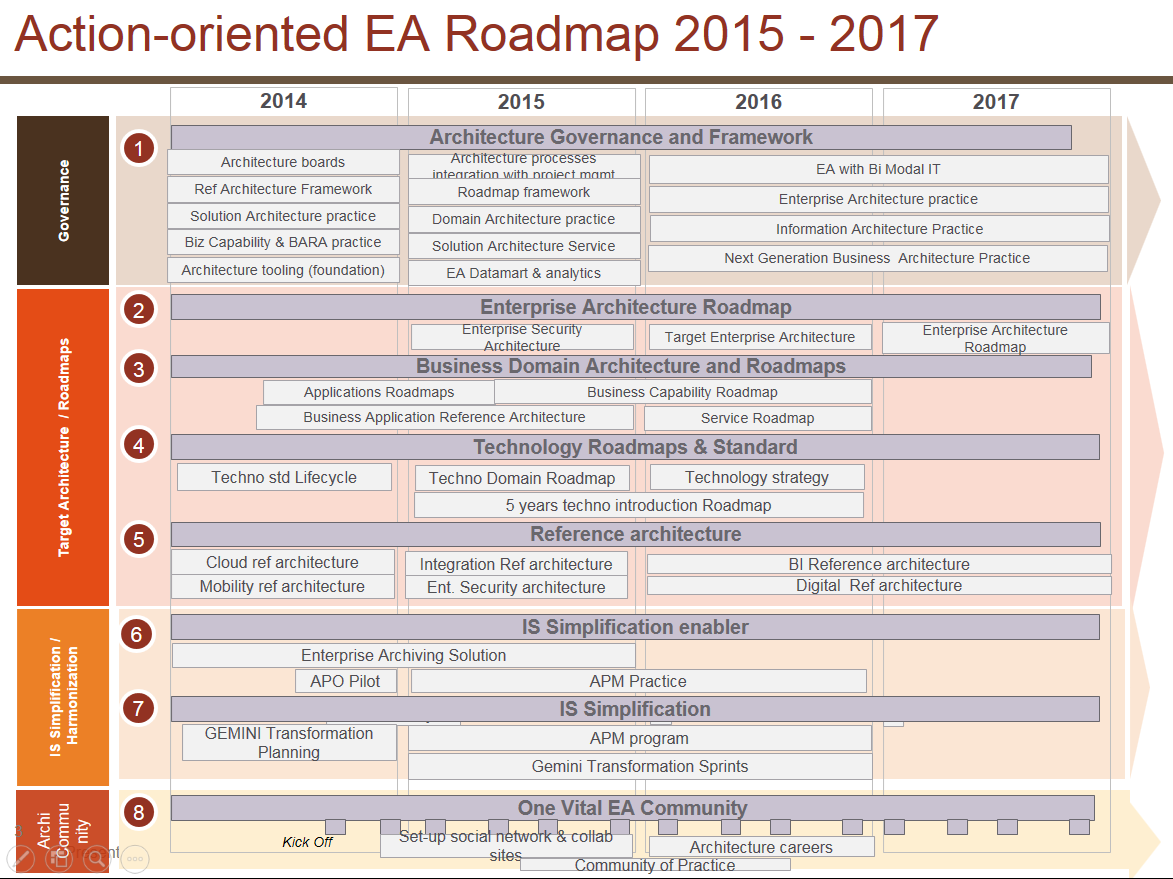EA Charter
Overview
Written by Serge Parisien, Manger, Enterprise Architecture Information and Technology at Canada Mortgage and Housing Corporation (CMHC)
- EA Operations and Governance
- Priorities and Mission Statement
- EA Responsibilities and Engagement
- EA Services
- Service Alignment
- EA Engagement in Demand Management
- EA Engagement in Project Delivery Life Cycle
- EA Stakeholders Interaction
- EA Program Delivery Roadmap
- EA Guiding Principles
- EA Stakeholders Interaction Models
What is EA?
- enabling the delivery of business capabilities
- stewarding technology resources to their most efficient and effective use
- minimizes unnecessary duplication and complexity in the technical environment
- accelerates delivery of critical business capabilities
- improves integration quality
- supports innovation, employee productivity, enterprise collaboration
- include technical, application, information and business architecture
- align IT investments with long-term strategy
- reduce technology lifecycle risk
- enable effective delivery of adaptive solutions and high quality information
EA’s job
- Across the enterprise to enable business outcomes (Enterprise-Wide Focus)
- Throughout the technology portfolio to ensure technologies work together (Technology Centric)
- Over time as technologies and the demands of the business evolve (Strategic Vision)
EA vs. project
- EA is more on Enterprise-wide + Biz strategy driven
- Project is more on local business + tactical driven

Communities of Practice (CoP)
- technical forums for discussing architecture and standards topics and making appropriate recommendations.
- like slack?
Priorities and Mission Statement
strategic planning <--mutually reinforce--> project engagement
EA operating priorities:
- Establish clear criteria for EA involvement
- Architect for business outcomes through business capability enablement
- Equip governance to support speed and scale
EA Function: We drive technology vision and direction in support of evolving business priorities through leadership, discipline and focus on value delivery.
EA will be delivering on its mandate by:
- Establishing a set of easy-to consume EA services.
- Tying delivery roles/teams business outcomes and not just architecture expertise. Also, optimize the use of EA resources by establishing a principled approach to determine the scope and depth of EA’s involvement.
- Establishing enterprise architecture as a broadly-practiced management discipline through collaboration and self-service as much as possible.
- Providing non-architects with simple tools that save time, improve project success rates, and reduce governance friction.
- Using the business capability model to help tier EA’s activities to meet differing, concurrent business objectives (e.g. cost efficiency in commoditized capabilities and agility and flexibility in core business capabilities).
EA Responsibilities and Engagement
Responsibilities
- Services
- Business Enablement
- e.g. review and provide comments and directions related to biz proposal
- Project Engagement
- e.g. provide functional and technical advice and expertise to solution-level architects from all domains.
- Portfolio Guidance
- e.g. develop, recommend and publish technology standards
- Technology Stewardship
- e.g. develop, recommend and publish technology standards
- People and Skills
- e.g. maintain a communities of practice, developer forum
EA Stakeholders

EA program capabilities roadmap

Business Capability Modeling
- representation of an organization's business model
- independent of the organization's structure, processes, people or domains
- capabilities that the organization needs to deliver its mission
EA Guiding Principles

- General Principles
- Align with the Business
- Include Business Continuity into Planning and Decision-Making
- Adopt Industry Best Practices
- Comply with Standards, Policies and Regulations
- Reuse before Buy, Buy before Build
- Deliver Maximum Benefits at the Lowest Cost and Risks
Information Principles
- Treat Information as a Corporate Asset
- Make Information Accessible, Shareable and Consumable
- Use Common Terminology and Definitions
Application Principles
- Design Simple and Easy to Use of Applications
- Adopt Flexibility and Adaptability
- Align with the Enterprise Architecture
- Apply Enterprise Architecture to Externally Hosted Applications
- Implement Service-Based Interfaces
- Adhere to Functional Domains
Technology and Security Principles
- Implement Changes Based on Requirements
- Control Technical Diversity and Suppliers
- Design Solutions with Interoperability in Mind
- Use a Risk-Based Approach to Security
- Design Solution with Security in Mind
EA Stakeholders
- Business Relationship Management (BRM) team.
- Technology Strategy team.
- Technology Risk & Disaster Recovery Planning
- Project Management Office (PMO)
- Corporate Process Redesign (CPR)
- Information Governance (IG)
- Corporate Information Management (CIM)
- Technology Development and Quality(TDQ) Purpose
- Technology Operations
EA definition
- ANSI/IEEE Std 1471-2000: “The fundamental organization of a system, embodied in its components, their relationships to each other and the environment, and the principles governing its design and evolution.”
- Cap Gemini: “Enterprise Architecture is the description and visualization of the structure of a given area of contemplation, its elements and their collaborations and interrelations links vision, strategy and feasibility, focusing on usability durability and effectiveness. Architecture enables construction, defining principles, rules, standards and guidelines, expressing and communicating a vision”
- Forrester, Gene Leganza, 2001: “Enterprise architecture consists of the vision, principles and standards that guide the purchase and deployment of technology within an enterprise”
- Gartner Group: “Enterprise architecture (EA) is the process of translating business vision and strategy into effective enterprise change by creating, communicating, and improving the key principles and models that describe the enterprise’s future state and enable its evolution.”
- Gartner Group, Philip Allega: “Enterprise architecture is the process that interweaves business and IT together”
- Institute for Enterprise Architecture Development: “Enterprise Architecture is about understanding all of the different elements that go to make up the enterprise and how those elements interrelate” (link is external)
- MIT Center for Information Systems Research: “Enterprise Architecture is the organizing logic for key business processes and IT capabilities reflecting the integration and standardization requirements of the firm’s operating model.”
- The ArchiMate Foundation: “A coherent whole of principles, methods, and models that are used in the design and realization of an Enterprise's organizational structure, business processes, information systems, and infrastructure”
- The Open Group: “By being inclusive with all other management frameworks, EA is a discipline that helps the Enterprise define , develop and exploit the boundaryless information flow (BIF) capabilities in order to achieve the Enterprise's Strategic Intent.”
- US Federal Enterprise Architecture Framework (FEAF): “Enterprise architecture is a management practice to maximize the contribution of an agency's resources, IT investments, and system development activities to achieve its performance goals. Architecture describes clear relationships from strategic goals and objectives through investments to measurable performance improvements for the entire enterprise or a portion (or segment) of the enterprise”
EA Benefits
Biz people don't care what is EA, instead they want to know what benefits can be brought from EA:
- Alignment with the company’s Business Model and Strategy
- Greater ability to respond to new business demands Integration
- Enable business changes, technologically based Business opportunities –innovation
- Readily available descriptive representations and documentation of the enterprise
- Reduce IT costs by consolidating, standardizing, rationalizing and integrating corporate information systems
- Enabling strategic business goals via better operational excellence
- Greater product leadership
- ...
EA Initiative
- by NAB (National Australia Bank)

EA Roadmap

Ref: